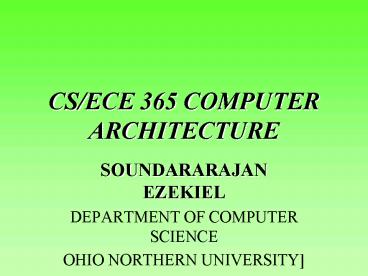CSECE 365 COMPUTER ARCHITECTURE PowerPoint PPT Presentation
1 / 21
Title: CSECE 365 COMPUTER ARCHITECTURE
1
CS/ECE 365 COMPUTER ARCHITECTURE
- SOUNDARARAJAN EZEKIEL
- DEPARTMENT OF COMPUTER SCIENCE
- OHIO NORTHERN UNIVERSITY
2
Datapath and control Introduction
- We did performance of a machine
- 3 factors--- instruction count---clock cycle
time--and clock cycles per instruction(CPI) - CPU time ICCPIClock cycle time
- clock cycle time 1/clock rate
- Clock cycle time Hardware technology and
organization - CPI Organization and instruction set
architecture - Instruction count Instruction set architecture
and compiler technology
3
continue
- We will discuss datapath and control unit for two
different implementation of the MIPS instruction
set - which includes
- Memory -reference instructions load word (lw)
and store word(sw) - Arithmetical-Logical Instruction add, sub, and
, or, slt - The instructions branch equal (beq) and jump (j)
4
Five Clock Cycles
- Instruction Fetch cycle(IF)
- Instruction decode/register fetch cycle(ID)
- Execution (EX)
- Memory Access(MEM)
- Write-Back Cycle(WB)
5
Notes
- A given ISA may be implemented with different
ways - Example Intel Pentium ISA has been implemented
in different ways, all of which support the same
ISA - Not only Intel, number of competitors --AMD,
Cyrix have implemented Pentium ISA
6
Basic of Architecture
- The functionality of the architecture centers
around the fetch-execute cycle, which is in some
sense the heart of the machine - 1. Fetch the next instruction to be executed from
memory - 2. Decode the opcode(specify the operation to be
performed) - 3. Read operand(s) from main memory or registers
if any - 4. Execute the instruction and store results
- 5. Go to step 1
7
- An architecture consists of a data section, which
contains registers and an ALU and a control
section - The data section is also referred as datapath
8
High level view of a architecture
CONTROL UNIT
Registers
ALU
Data path (data section)
Control section
SYSTEM BUS
9
MIPS major functional unit and the connections
Address Instruction Instruction Memory
DATA Registers
ALU
PC
ADDRESS DATA
DATA MEMORY
10
- send the program counter to memory that contain
code and fetch the instruction from that memory - read 1 or 2 registers, using fields of
instructions to select the register to read for
lw we need 1 register, most others need
2-registers - uses ALU
- memory reference instruction address
calcualtion - alu instruction operation execution
- branches comparisons
11
- after ALU
- memory-ref instruction--- access memory either
write for store or read data for load - alu instruction-- must write data back to
registers - branch ins--- need to change the instruction
according based on comparison
12
Logic Design
- functional units in MIPS implementation consists
of 2 different type logic elements - combinational outputs are depends only on the
current inputs - given the same input, combinational element
always produce the same output - ALU-- MIPS functional is combinational --- there
is no internal storage
13
- State an element contain state that means it
has some internal storage - we call these elements are state elements
- Instruction, data memory, and all registers are
state elemets - if we pull the plug, we can restart the computer
by using the information stored before we pull
the plug
14
- State 2 input one output--
- INPUT 1.data value to be written into the
element-- 2. clock (determine when the date value
is written) - OUTPUTprovides the value that was written in an
earlier clock cycle - example memories, and registers-- clock is used
to determine when the state element should be
written-- state element can be read at any time
15
sequential
- logic components that contains state are also
called sequential because their outputs depend on
both their inputs and the contents of the
internal state
16
Clocking methodology
- It defines when the signal can be read and when
they can be written - time is important because if a signal is
written at the same time it is read, the value of
read could be old value-- or mixed values-- - clocking methodology is to designed to prevent
this problem
17
edge-triggered clocking methodology
- any values stored in the machine are updated only
on a clock edge. gt state elements all update
their internal storage on the clock edge - following slide shows --2 state elements --
surrounding a block of combinational logic--
which operate on a single clock cycle - all three stages in one single clock cycle
18
Combinational Logic
State element 1
State element 2
Clock cycle
Combinational logic, state elements, and the
clock are closely related
19
Note
- not showing write control signal when the state
element is written on every active clock edge - if state is not updated every clock-- we need
write control signal --- this case both the clock
cycle and write control signal are input--state
element will change only if write control signal
is asserted and clock edge occurs
20
- an edge-triggered methodology allows us to read
the contents of a register, send the value
through some combinational logic, and write that
registers in the same clock cycle
Combinational logic
State ele
21
Note
- nearly all of these state and logic elements are
32 bit input and output( that is the data handle
by the processor) - building datapath
- simple/multicycle implementation
- microprgramming
- CAD--application
- use datapath for pipelining

